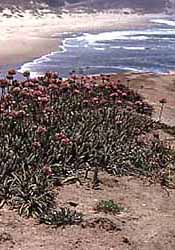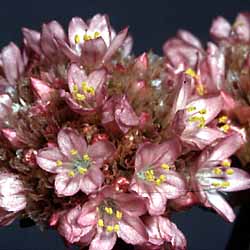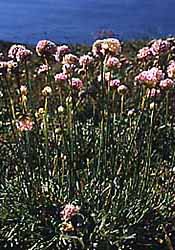 |
 |
 |
The Polygonaceae are a group of about 30 to 50 genera and more than 1000 species of caryophyllid flowering plants that are closely related to the Plumbaginaceae. Like most plants, but unlike most caryophyllids, the Polygonaceae have anthocyanin pigments. For this reason, and because they differ from typical caryophyllids in other ways, there has been debate for a long time about the relationship of the Polygonaceae to the other caryophyllids. However, recent molecular studies support this long-suspected relationship.
 |
 |
 |
Extreme habitats : The california native Armeria maritima var. californica (Sea-Pink) is one of only two species of Plumbaginaceae of salt found in these soils.
The largest genera in this family are Polygonum, Rumex, Eriogonum, Coccoloba, and Calligonum. The genus Polygonum includes about 250 species and so includes about one-quarter of the Polygonaceae. It is commonly called "knotweed" or "smartweed" in English and includes several common weedy plants, and well as a few perennial and woody species. The flowers are often white or pinkish, and are pollinated by insects. Another common and weedy genus is Rumex, commonly called "dock" or "sorrel", and there are about 200 species. Sorrel leaves are tangy and edible, and have become popular in salads. This genus is common as a weed in pastures, where it often gives a reddish color to the field or meadow because of the reddish tint of its flowers and seeds. Unlike knotweed, sorrel is anemophilous (wind pollinated). When the seeds are matured, part of the reddish perianth (sepals and petals) fuse to the outside of the tiny fruit and provide a set of wings and hooks to help disperse the seed.
Eriogonum, with 200-250 species, includes both tiny herbaceous plants and small shrubs. This genus is easily recognized because the plants are often covered in dense gray woolly hairs; most species grow in western North America. The genus Coccoloba includes about 125 species, and is one of the few tropical members of the group. Most species of Polygonaceae are herbaceous and grow in temperate regions of the Northern Hemisphere, though Coccoloba is usually woody and is found in tropical Mesoamerica. Flowers of this genus have a foetid odor, which attracts flies and beetles as pollinators. When fully mature, the "berries" of Coccoloba are edible and can be used to make jelly, though they are not true berries. The fleshy edible part of the fruit actually develops from the perianth, and not from the ovary wall. The last of the large genera is Calligonum, which includes about 100 species of shrubs that grow in central Asia. Together with the other four genera mentioned above, this accounts for about ninety percent of all Polygonaceae species.
there are some members of this family in Argentina, Indonesia, Australia, and New Zealand.
Fossils of the Plumbaginaceae are not common, but pollen from both subfamilies is known from the Miocene. Fossil pollen that resembles pollen of living Aegialitis and Plumbago (both in subfamily Plambagoideae) has been reported from the Upper and Middle Miocene of Borneo, respectively. Fossil pollen comparable to either living Armeria or Limonium is known from the Upper Miocene of Spain. While the Plumbaginaceae fossil record extends only back to the Miocene, that of their sister group, the Polygonaceae extends back as least as far as the Paleocene. See Muller (1981) for more information.

Sources:
Jan Muller, 1981. Fossil pollen records of extant angiosperms. The Botanical Review 47(1):1-142.

